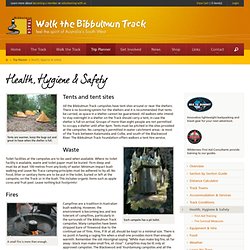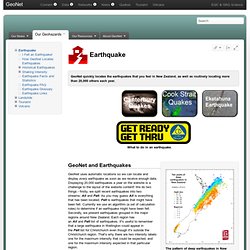

Conservation de la biodiversité. Mountaineering gear at wholesale prices. Health, Hygiene & Safety - Bibbulmun Track Foundation. Tents and tent sites All the Bibbulmun Track campsites have tent sites around or near the shelters.

There is no booking system for the shelters and it is recommended that tents be carried, as space in a shelter cannot be guaranteed. All walkers who intend to stay overnight in a shelter on the Track should carry a tent, in case the shelter is full on arrival. Groups of more than eight people are not permitted to occupy a shelter until after 6pm. Tents must be pitched in the sites provided at the campsites. Waste Toilet facilities at the campsites are to be used when available. Fires Campfires are a tradition in Australian bush walking. See also: fires at campsites and fire survival measures. All walkers must take care with fire.
Water. Top 10 Dinosaurs That Aren't What They Were. Animals Dinosaurs are not what they used to be. I’m not talking about birds being dinosaurs and all that, but about those extinct giants of the Mesozoic we all grew up loving. As new studies and discoveries are made, dinosaurs are becoming so much different from the way we always imagined them that, today, many of us have trouble recognizing even our childhood favorites. I give you ten classic dinosaurs that have changed radically due to new paleontological discoveries. And they may still change a lot in the future! Stegosaurus is perhaps the most recognizable of all prehistoric animals; it is nearly impossible to mistake it for another creature. However, Stegosaurus, like many dinosaurs, has changed a lot since. Also, the tail spike cluster (known among paleontologists as the “thagomizer”) didn’t actually point upwards, but sideways. Oh, and by the way, Stegosaurus’ brain was actually NOT the size of a walnut, but about twice as big.
Biomain. Earthquake. GeoNet quickly locates the earthquakes that you feel in New Zealand, as well as routinely locating more than 20,000 others each year.

What to do in an earthquake. GeoNet uses automatic locations so we can locate and display every earthquake as soon as we receive enough data. Displaying 20,000 earthquakes a year on the website is a challenge to the layout of the website content! We do two things - firstly, we split recent earthquakes into two streams; All and Felt. As you may guess All is everything that has been located. Other significant events within the greater south-west Pacific region may be detected by our equipment, but we do not routinely locate these as the geometry of our recording network does not allow accurate epicentres and magnitudes to be determined. I Felt an Earthquake! If you have felt an earthquake recently, we would like to know where you were and what happened to you. How GeoNet Locates Earthquakes Historical Earthquakes Shaking Intensity Earthquake Facts and Statistics. University Kayak Club - Fundamentals of Kayak Camping Gear.
© 2002, by Mike Wagenbach ( wagen@u.washington.edu ) In addition to basic day-trip paddling gear (see “What to bring on a sea kayaking trip”), kayak-camping trips require loading the boats with the requirements for a few days of simple but comfortable living: water; food and probably cooking equipment; clothing in addition to that worn while paddling, including rain gear and enough insulation to be happy after dark in some breeze; personal care supplies; artificial lights; tools and other supporting equipment; and a place to sleep, as well as possibly additional shelter so camp chores can be done out of the rain without trashing the inside of a tent (or burning it down).

Some of these categories are summarized below in a table, which lists “minimal, typical, and extravagant” variations, as well as some items deemed “inappropriate,” due to excessive bulk or unsuitability. Detailed discussion of various items precedes the table. When in doubt, try to err on the side of stern-heaviness.
Welcome to your account! Web content. Home of CELLS alive! Add anything from anywhere. Organize all your interests naturally. Explore your community of interests. WoodGas Stove. WoodGas Stove A few ideas about a stove developed by Ray Garlington Late September 2003, Ray developed a page on a new "batch-loaded, inverted down-draft gassifier" stove.

This type of stove has quite a following, but most of the versions are not designed well for the backpacker. Ray's design is just about optimal for the hiker. That report is here: Garlington Wood Gas Stove I did a little experimenting with the stove in the first weekend of the month. I was interested in fitting everything together. Instead of the pot support designed by Ray, I use four bent wires. Ray's page is quite clear about how to pack the stove with sticks and light it.
This is what my testing stove looks like, except that when I use it, it has a tin foil windscreen around it. A few other notes: I found, after reading Ray's instructions again, that it works better to fill the can about half full of pencil diameter (7 mm) sticks and about half full of sticks no more than 2 mm across. For the gearheads: Share all of this!